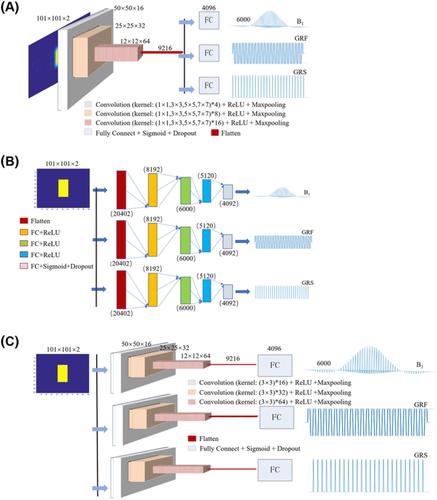当前位置:
X-MOL 学术
›
NMR Biomed.
›
论文详情
Our official English website, www.x-mol.net, welcomes your
feedback! (Note: you will need to create a separate account there.)
Multi‐task convolutional neural network‐based design of radio frequency pulse and the accompanying gradients for magnetic resonance imaging
NMR in Biomedicine ( IF 2.7 ) Pub Date : 2020-11-16 , DOI: 10.1002/nbm.4443 Yajing Zhang 1 , Ke Jiang 2 , Weiwei Jiang 1 , Nan Wang 3 , Alan J Wright 4 , Ailian Liu 3 , Jiazheng Wang 2
NMR in Biomedicine ( IF 2.7 ) Pub Date : 2020-11-16 , DOI: 10.1002/nbm.4443 Yajing Zhang 1 , Ke Jiang 2 , Weiwei Jiang 1 , Nan Wang 3 , Alan J Wright 4 , Ailian Liu 3 , Jiazheng Wang 2
Affiliation

|
Modern MRI systems usually load the predesigned RFs and the accompanying gradients during clinical scans, with minimal adaption to the specific requirements of each scan. Here, we describe a neural network‐based method for real‐time design of excitation RF pulses and the accompanying gradients' waveforms to achieve spatially two‐dimensional selectivity. Nine thousand sets of radio frequency (RF) and gradient waveforms with two‐dimensional spatial selectivity were generated as the training dataset using the Shinnar–Le Roux (SLR) method. Neural networks were created and trained with five strategies (TS‐1 to TS‐5). The neural network‐designed RF and gradients were compared with their SLR‐designed counterparts and underwent Bloch simulation and phantom imaging to investigate their performances in spin manipulations. We demonstrate a convolutional neural network (TS‐5) with multi‐task learning to yield both the RF pulses and the accompanying two channels of gradient waveforms that comply with the SLR design, and these design results also provide excitation spatial profiles comparable with SLR pulses in both simulation (normalized root mean square error [NRMSE] of 0.0075 ± 0.0038 over the 400 sets of testing data between TS‐5 and SLR) and phantom imaging. The output RF and gradient waveforms between the neural network and SLR methods were also compared, and the joint NRMSE, with both RF and the two channels of gradient waveforms considered, was 0.0098 ± 0.0024 between TS‐5 and SLR. The RF and gradients were generated on a commercially available workstation, which took ~130 ms for TS‐5. In conclusion, we present a convolutional neural network with multi‐task learning, trained with SLR transformation pairs, that is capable of simultaneously generating RF and two channels of gradient waveforms, given the desired spatially two‐dimensional excitation profiles.
中文翻译:

基于多任务卷积神经网络的射频脉冲及其伴随梯度磁共振成像设计
现代 MRI 系统通常在临床扫描期间加载预先设计的 RF 和伴随的梯度,对每次扫描的特定要求的适应最小。在这里,我们描述了一种基于神经网络的方法,用于实时设计激励射频脉冲和伴随的梯度波形,以实现空间二维选择性。使用 Shinnar-Le Roux (SLR) 方法生成了九千组具有二维空间选择性的射频 (RF) 和梯度波形作为训练数据集。使用五种策略(TS-1 到 TS-5)创建和训练神经网络。将神经网络设计的 RF 和梯度与其 SLR 设计的对应物进行比较,并进行 Bloch 模拟和体模成像以研究它们在自旋操作中的性能。± 0.0038 在 TS-5 和 SLR 之间的 400 组测试数据和幻像成像之间。还比较了神经网络和 SLR 方法之间的输出 RF 和梯度波形,TS-5 和 SLR 之间的联合 NRMSE,同时考虑了 RF 和梯度波形的两个通道,为 0.0098 ± 0.0024。RF 和梯度是在商用工作站上生成的,TS-5 需要大约 130 毫秒。总之,我们提出了一个具有多任务学习的卷积神经网络,使用 SLR 变换对进行训练,在给定所需的空间二维激励剖面的情况下,该网络能够同时生成 RF 和两个梯度波形通道。
更新日期:2021-01-04
中文翻译:

基于多任务卷积神经网络的射频脉冲及其伴随梯度磁共振成像设计
现代 MRI 系统通常在临床扫描期间加载预先设计的 RF 和伴随的梯度,对每次扫描的特定要求的适应最小。在这里,我们描述了一种基于神经网络的方法,用于实时设计激励射频脉冲和伴随的梯度波形,以实现空间二维选择性。使用 Shinnar-Le Roux (SLR) 方法生成了九千组具有二维空间选择性的射频 (RF) 和梯度波形作为训练数据集。使用五种策略(TS-1 到 TS-5)创建和训练神经网络。将神经网络设计的 RF 和梯度与其 SLR 设计的对应物进行比较,并进行 Bloch 模拟和体模成像以研究它们在自旋操作中的性能。± 0.0038 在 TS-5 和 SLR 之间的 400 组测试数据和幻像成像之间。还比较了神经网络和 SLR 方法之间的输出 RF 和梯度波形,TS-5 和 SLR 之间的联合 NRMSE,同时考虑了 RF 和梯度波形的两个通道,为 0.0098 ± 0.0024。RF 和梯度是在商用工作站上生成的,TS-5 需要大约 130 毫秒。总之,我们提出了一个具有多任务学习的卷积神经网络,使用 SLR 变换对进行训练,在给定所需的空间二维激励剖面的情况下,该网络能够同时生成 RF 和两个梯度波形通道。









































 京公网安备 11010802027423号
京公网安备 11010802027423号